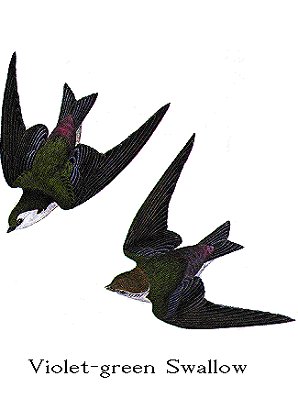
| Family VI. HIRUNDINAE. SWALLOWS. GENUS I. HIRUNDO, Linn. SWALLOW. |
Next >> |

Family |
VIOLET-GREEN SWALLOW. [Violet-green Swallow.] |
| Genus | HIRUNDO THALASSINA, Swains. [Tachycineta thalassina.] |
Of this, the most beautiful Swallow hitherto discovered within the limits
of the United States, the following account has been transmitted to me by my
friend Mr. NUTTALL. "We first met with this elegant species within the
table-land of the Rocky Mountains, and they were particularly abundant around
our encampment on Harris Fork, a branch of the Colorado of the west. They are
nearly always associated with the Cliff Swallow, here likewise particularly
numerous. Their flight and habits are also similar but their twitter is
different, and not much unlike the note of our Barn Swallow. In the Rocky
Mountains, near our camp, we observed them to go in and out of deserted nests of
the Cliff Swallows, which they appeared to occupy in place of building nests of
their own. We saw this species afterwards flying familiarly about in the
vicinity of a farm-house (M. LE BOUTE's) on an elevated small isolated prairie
on the banks of the Wahlamet; and as there are no cliffs in the vicinity, they
probably here breed in trees, as I observed the White-bellied Martin do. This
beautiful species in all probability extends its limits from hence to the
table-land of Mexico, where Mr. BULLOCK, it seems, found it.
Mr. TOWNSEND, who afterwards had better opportunities of observing the
habits of this bird, thus speaks of it:--"Aguila chin chin of the Chinook
Indians, inhabits the neighbourhood of the Colorado of the west, and breeds
alone, its margins on bluffs of clay, where it attaches a nest formed of mud and
grasses resembling in some measure that of the Cliff Swallow, but wanting the
pendulous neck in that of the latter species. The eggs are four, of a dark clay
colour, with a few spots of reddish-brown at the larger end. This species is
also found abundant on the lower waters of the Columbia river, where it breeds
in hollow trees."
Mr. TOWNSEND also informs me that in the neighbourhood of the Columbia
river, the Cliff Swallow attaches its nest to the trunks of trees, making it of
the same form and materials as elsewhere. From the above facts, and many
equally curious, which I have mentioned, respecting the variations exhibited by
birds in the manner of forming their nests, as well as in their size, materials,
and situation, it will be seen that differences of this kind are not of so much
importance as has hitherto been supposed, in establishing distinctions between
species supposed by some to be different, and by others identical. To give you
some definite idea of what I would here impress upon your mind, I need only say
that I have seen nests of the Barn or Chimney Swallow placed within buildings,
under cattle-sheds, against the sides of wells, and in chimneys; that while some
were not more than three inches deep, others measured nearly nine; while in some
there was scarcely any grass, in others it formed nearly half of their bulk. I
have also observed some nests of the Cliff Swallow in which the eggs had been
deposited before the pendent neck was added, and which remained so until the
birds had reared their brood, amidst other nests furnished with a neck, which
was much longer in some than in others. From this I have inferred that nests
are formed more or less completely, in many instances, in accordance with the
necessity under which the bird may be of depositing its eggs.
HIRUNDO THALASSINUS, Swains. Syn. of Mex. Birds, Phil. Mag. for 1827,
p. 365.
VIOLET-GREEN SWALLOW, Hirundo thalassina, Aud. Orn. Biog.,
vol. iv. p. 597.
Bill narrower than in the preceding species; wings extremely long,
extending far beyond the tail, which is emarginate. Upper part of head deep
green, gradually shaded into the dark purple of the hind neck; back rich
grass-green, rump and upper tail-coverts carmine purple; a line over the eye,
cheeks, and all the lower parts pure white, excepting the wing-coverts, which
are light grey. Female with the upper part of the head and hind neck light
greyish-brown, glossed with green; the back as in the male, the rump
greyish-brown; lower parts white, anteriorly tinged with grey.
Male, 4 10/12, wing 4 6/12.
| Next >> |